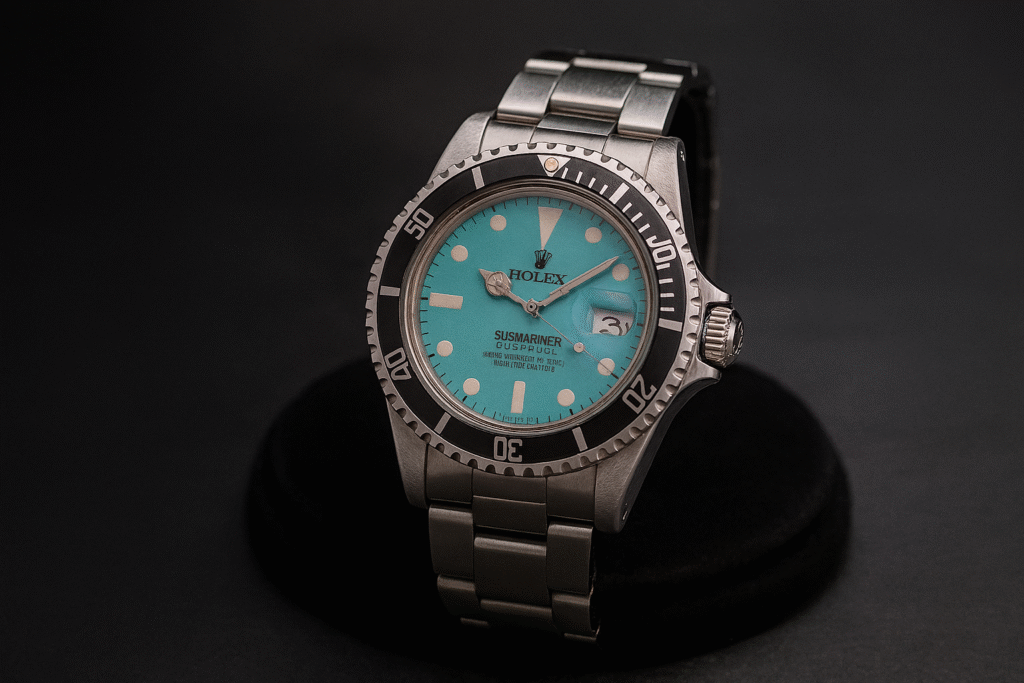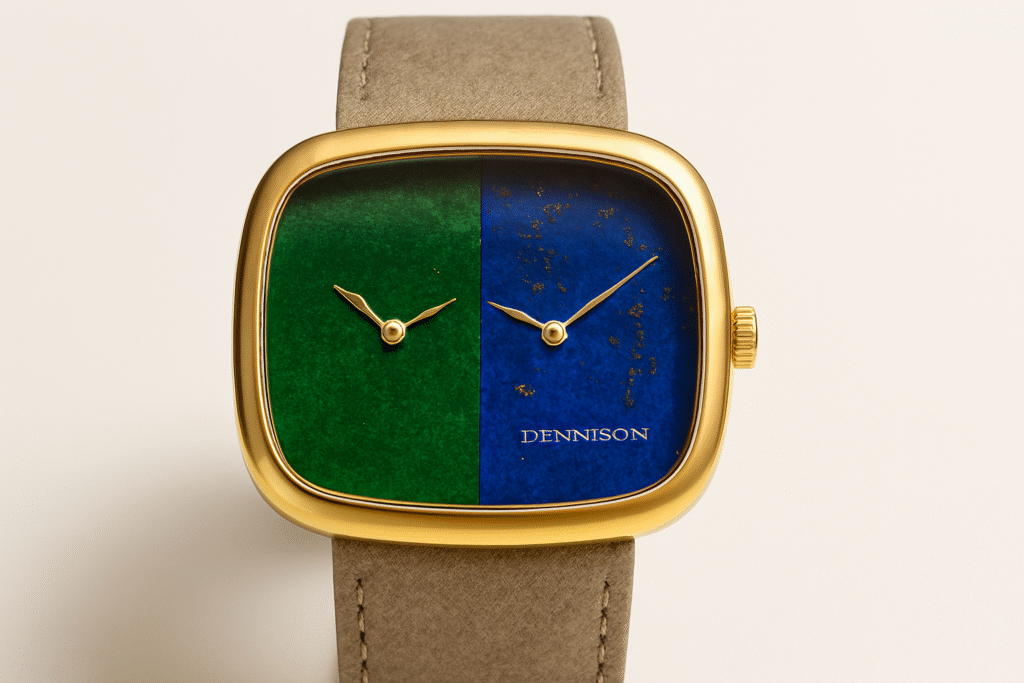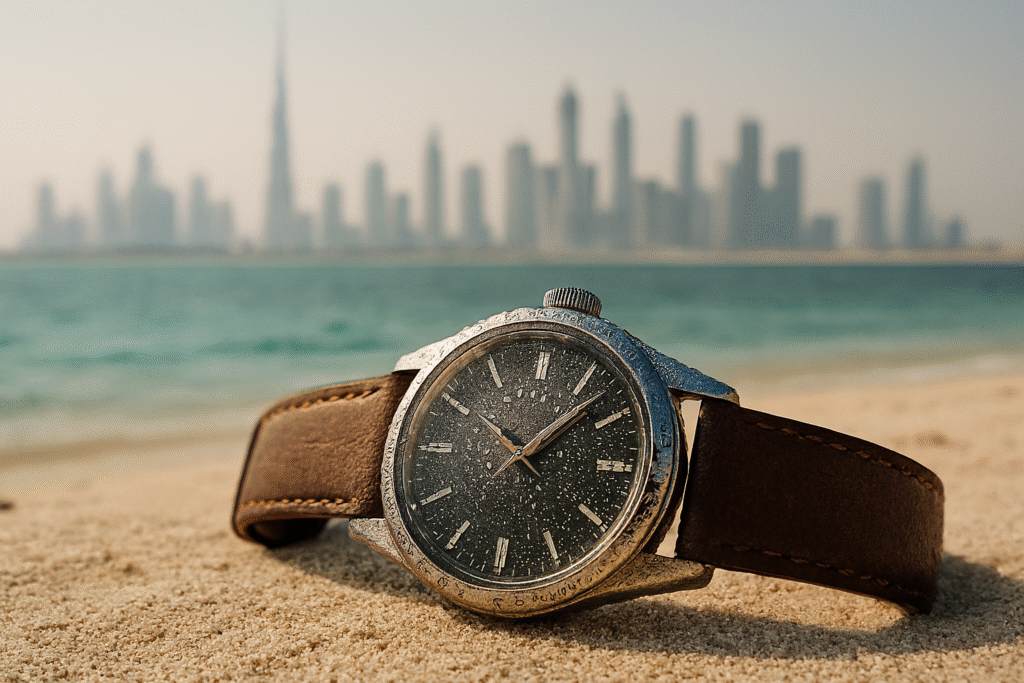In the late 1970s, a contestant on The Price is Right walked away with what looked like a simple door prize. Decades later, that very prize has resurfaced at Bob’s Watches — and it happens to be the Tiffany & Co. Rolex Submariner Ref. 1680. Known as one of the rarest vintage Rolex Submariners ever made, this piece combines Tiffany dual-signature branding, full provenance, and cultural significance.
The watch in question is a 1978 Rolex Submariner Ref. 1680, remembered as the first Submariner to include a date display. More importantly, this example stands out because of the Tiffany & Co. co-branding on the dial. Collectors value such dual-signed Rolexes for both rarity and cultural importance.
Why this Tiffany & Co. Submariner matters
- First Submariner model with a date window (Ref. 1680).
- Tiffany & Co. dual-signature, among the most desirable Rolex features.
- Provenance linked directly to a U.S. game show prize.
- Daily use by the original owner, adding authenticity to the story.
As Paul Altieri, CEO of Bob’s Watches, explained:
“It’s not just the rarity of the Tiffany dial, it’s the story. A game show prize became a cherished daily companion — and now, a world-class collector’s piece.”
Rolex collecting in numbers
Since 2010, Bob’s Watches has completed over 50,000 Rolex transactions. During the same period, Tiffany-signed Rolexes have increased in collector value by more than 35%. Furthermore, auction houses confirm record-breaking demand for dual-signed dials.
Q&A: Collectors want to know
Q: Why are Tiffany-signed Rolexes so valuable?
A: Dual-signed dials are rare because only a few retailers had this partnership. As a result, Tiffany-branded Rolexes enjoy even greater desirability.
Q: How can you authenticate a Tiffany Rolex?
A: Collectors should check correct serial ranges, dial printing consistency, and period-specific details. In addition, Bob’s Watches subjects each watch to strict authentication.
Q: What sets this Submariner apart from others?
A: Its unique story — a U.S. game show prize worn daily before entering the collector’s market. Consequently, it blends American pop culture with Rolex heritage.
Industry expertise and recognition
Bob’s Watches is widely known as the leading pre-owned Rolex marketplace in the United States. Through a transparent buy/sell model, rigorous authentication, and an educational approach, the company has built trust with new buyers and seasoned collectors alike.
Altieri added:
“We see ourselves as caretakers of history. Our responsibility is not only to authenticate and preserve but also to share the stories that make each Rolex unique.”
Suggested Reading:
If you’re interested in the history of Rolex co-branding, you can also explore the guide on Understanding Rolex Dial Variations.
For collectors focused on provenance, the article on How to Authenticate a Vintage Rolex provides a step-by-step approach.
And if you’re drawn to the cultural side, don’t miss the feature on Rolex Watches in American Pop Culture.
This comprehensive global cuisine FAQ covers everything about Asian and Western food and drinks. Whether you’re exploring international cooking techniques or discovering new flavors, this global cuisine FAQ answers the most frequently asked questions about world food traditions, ingredients, and culinary practices from both Eastern and Western cultures.
Global Cuisine FAQ: Asian & Western Food & Drinks
Food reveals cultural contrasts in clear and delicious ways. From cooking methods to dining customs, Asian and Western cuisines showcase unique traditions while also offering fascinating overlaps. Below, you’ll find answers to the most common questions about these culinary worlds.
Understanding Core Differences in Cuisine
1. What distinguishes Asian and Western culinary traditions?
Asian meals often rely on rice or noodles as a foundation. Flavors usually come from soy sauce, ginger, garlic, and a wide variety of spices. Meanwhile, Western gastronomy emphasizes bread, potatoes, and pasta. Dairy plays a key role, with butter, cream, and cheese giving richness to many dishes. Herbs such as rosemary and thyme highlight European cooking. These contrasts create distinct dining habits and flavor profiles.
2. Are Asian dishes always spicy?
No, not at all. While cuisines from Thailand and parts of India feature bold use of chilies, not every dish follows this pattern. Japanese sushi, Chinese dim sum, and Korean bulgogi are mild examples. In fact, Asian cuisines range from fiery to delicate, showcasing a rich palette of flavor.
Western Breakfast Staples and Comfort Foods
1. What constitutes typical Western morning meals?
Western breakfasts often include eggs, bacon, and toast. Pancakes, waffles, and cereal are also popular choices. These hearty starts are usually enjoyed with coffee, tea, or juice, providing both energy and comfort.
2. What represents popular Western comfort foods?
Comfort foods in the West speak to nostalgia and indulgence. Creamy macaroni and cheese, pizza, and hearty casseroles are favorites. Similarly, burgers and fried chicken have wide appeal. Because they are warm, filling, and familiar, these dishes strongly connect to emotion.
Cultural Dining Practices
1. Do all Asian cultures employ chopsticks?
No. Chopsticks dominate in East Asia—China, Japan, and Korea. However, Southeast Asia prefers spoons and forks, while India and parts of the Middle East often use flatbreads or hands. This diversity highlights how food customs closely reflect culture.
2. Why are some Asian foods fermented?
Fermentation preserves food while also enhancing nutrition and flavor. Korean kimchi, Japanese miso, and Indonesian tempeh show how tradition meets health benefits. These foods are valued not only for taste but also for their role in well-being.
Common Western Beverages
1. What beverages are common with Western meals?
Western dining often features water, soda, or fresh juice. Alcohol also has a strong cultural connection, with wine served at European dinners and beer central in North America. In the southern United States, sweet iced tea is a staple.
Dietary Flexibility and Options
1. Can one discover plant-based options easily?
Yes. Asian cuisines offer tofu stir-fries, lentil dals, and vegetable curries that are naturally vegetarian. Western food, similarly, embraces plant-based eating. Salads, vegetarian pastas, and vegan burgers have grown popular, making meat-free dining accessible worldwide.
Unique Asian Drinks to Explore
1. What are some unique Asian beverages?
Asia provides a wide variety of distinctive drinks. Bubble tea, from Taiwan, combines tea with chewy tapioca pearls. Japanese sake, made from rice, holds deep cultural meaning. Strong Vietnamese iced coffee, sweetened with condensed milk, adds a bold twist compared to Western brews.
Portion Sizes and Dining Habits
1. How do portion sizes compare?
Western meals often emphasize large servings, reflecting abundance. By contrast, Asian meals are usually smaller yet balanced, encouraging sharing and mindful eating. This creates different social experiences around the table.
The Art of Fusion Cuisine
1. Is it feasible to integrate Asian and Western flavors?
Absolutely. Fusion cuisine blends traditions in creative ways. For instance, teriyaki burgers combine Japanese flavors with American fast food, while kimchi tacos bring Korean spice to Mexican street food. These playful mixes show how food bridges cultures.



